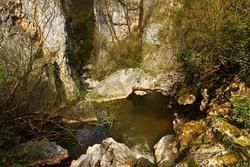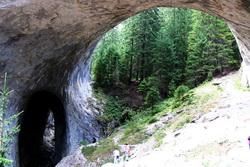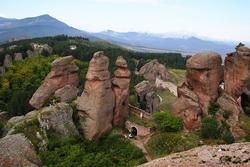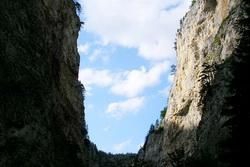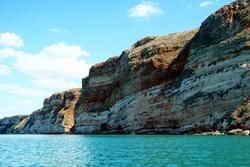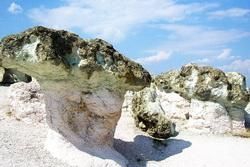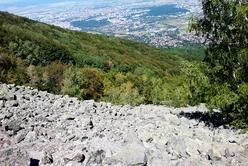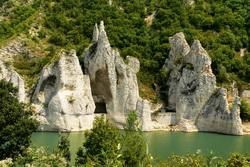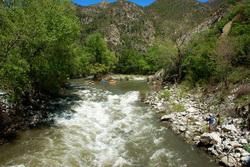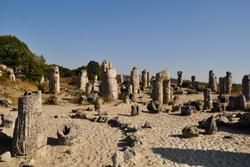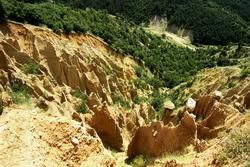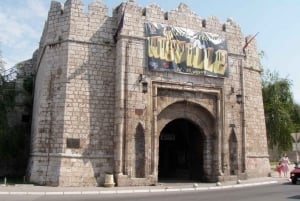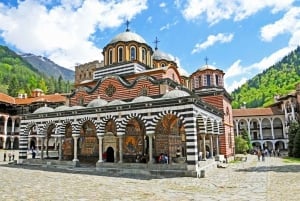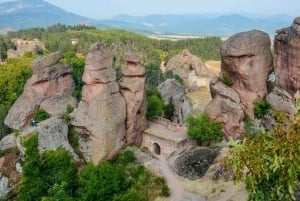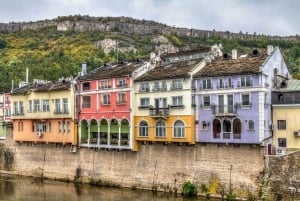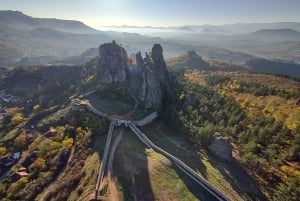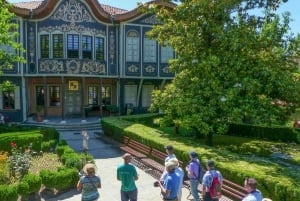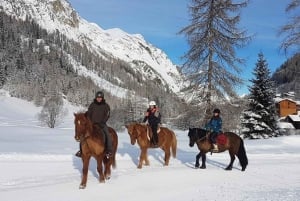Rock Formations in Bulgaria
Trigrad Gorge in the Rhodope Mountains, Tran Gorge near the Serbian border and Kresna Gorge in Southwestern Bulgaria are three remarkable rock formations that wait to be explored by nature-loving tourists.
Trigrad Gorge is located in the southern part of the Rhodopes, just a few kilometres away from the village of Shiroka Laka, an architectural and folklore reserve, and right next to the Devil’s Throat, one of the most famous caves on the territory of the country. It is made up of two 300 m-high and 7 km-long vertical rocks with a river in the middle. Trigrad River flows through the beautiful gorge and pours its waters straight in the Devil’s Throat only to reemerge again as a big karst spring half a kilometer down the road.
Tran Gorge on the River Erma lies 75 km west of Sofia, the capital of Bulgaria, and is one of the famous tourist attractions in the region. Its steep rocks stand 100 m tall. A lovely hiking trail starts at the southern end of the gorge that covers a distance of 13 km and reveals the full natural appeal of the area.
The 18 km-long Kresna Gorge may not be the most impressive natural wonder in the country but it sure does offer a lot of excitement to tourists. Thanks to the swift waters of Struma River, it provides excellent opportunities for high-octane outdoor activities such as rafting and kayaking. And indeed, every season the place bustles with adrenaline junkies who just can’t get enough of Struma’s turbulent waters and rapids. The gorge lies about 100 km south of Sofia.
Belogradchik Rocks:
This can easily be Bulgaria’s most popular natural landmark. So far it has been included in countless numbers of domestic and international lists of natural phenomena and has topped most of them. It was even among the 200 contestants in The New Seven Wonders of the World competition. Well, it didn’t manage to get to the last seven but so what. It is still one of the most beautiful rock formations in the world. The Belogradchick Rocks are located on a hill just outside the little town of Belogradchik in the northeastern end of the country, 175 km north of Sofia and approximately 50 km south of Vidin. To put it simply, this is a cluster of interesting-looking rocks that spreads over a territory of about 50 sq km. Such a plain definition, however, doesn’t do justice to the place. Each stone figure there has a personality and soul. The dinosaur is large and threatening, the schoolgirl with her school bag on is slim and beautiful, the castle is majestic, the Madonna and the horseman are mysterious and imposing, Adam and Eve are meek and humble...the list goes on and on and on… But words aren’t good enough to convey the beauty of the place. You just have to see it to feel it.
The Stone Rivers:
The stone rivers are one of the most unique features of
Vitosha, the mountain that stands tall just outside the capital city of
Sofia. They are made up of huge round boulders and usually take up vast areas. The region in the southwestern part of the mountain called Zlatnite Mostove (the Golden Bridges) is where the largest stone river in Vitosha can be found. It is approximately 2 km long and 150 m wide and is one of the mountain’s best-known tourist attractions.
The Standing Stones:
This curious rock formation is situated 20 km west of
Varna. It represents a group of hollow tube-shaped stone pillars of different height and size spread over a territory of 7 sq km. The stones appear as if nailed to the ground (hence the Bulgarian name Pobiti Kamani which can literally be rendered as nailed stones in English) and some of them come in unusual shapes. The camel, the stone guardians, the throne and the stone wood are the most popular ones.
Chudnite Skali (the Marvellous Rocks):
The people who have seen the Marvellous Rocks often describe them as a striking white castle-like figure emerging from the cool waters of Tsonevo Reservoir, 90 km west of Varna. Actually, this is just a cluster of ten limestone rocks which have been exquisitely carved and shaped by the water and the wind. The region is perfect for tourists who enjoy the peaceful atmosphere of the countryside. Tsonevo Reservoir is also a fine fishing spot.
The Melnik Pyramids:
The steep rocks overhanging
Melnik, the smallest town in Bulgaria, situated in the southwestern part of the country, are extremely popular with tourists who are keen on nature. They can be defined as natural pyramids with sheer sandy slopes and constantly changing shapes. That’s right, their forms are not final. This is due to the never-ending effects of external forces such as heat, cold, rain, and wind which chisel and alter them all the time.
The Pyramids of Stob Village:
Located in the western part of
Rila Mountain, the Stob Pyramids are among the most unusual rock formations in Bulgaria. Although labeled pyramids, the majority of them look more like 10-metre-tall, cone-shaped stone mushrooms on account of their stone caps. Just like the Melnik Pyramids, though, their forms are not strictly fixed and depend to a great extent on the weather conditions.
The Limestone Cliffs near Bolata Cove:
The sheer cliffs of Bolata Nature Reserve in the northern part of the
Black Sea Coast are a must-see for every person who claims to have a soft spot for natural phenomena. Their limestone coat gently melts with the turquoise waves of the sea painting it white and… no, wait. Words just don’t do justice to this magnificent place so you’d better go and see it with your own eyes. Don’t forget to get a boat, though - the true beauty of this rock formation is only visible from the sea.
The Stone Mushrooms:
The amazing Stone Mushrooms near the town of Kardzhali in Southern Bulgaria came into existence thousands of years ago as a result of intensive underwater volcanic activity. The 2.5-metre-tall mushrooms are characterised by pink stumps and green caps and are among the most bizarre rock formations in the country.
Chudnite Mostove (the Marvellous Bridges):
The Marvellous Bridges, also known as the Marvellous Rocks, are one of the highlights of the Western
Rhodope Mountains. Basically, these are two massive bridge-like marble rocks with a river flowing under them. The bigger of the two is 100 m long and up to 15 m wide and is relatively safe for tourists to walk on, while the other one is virtually inaccessible. According to geologists it was the river that played instrumental role for the shaping of the rocks. Its relentless waters kept digging and digging and eventually they managed to cut through the once solid rocks, thus forming beautiful arches.
Photos by E.Bliznashka, D.Bibishkov, D.Alexov, A.Alexov, T.Halkova


